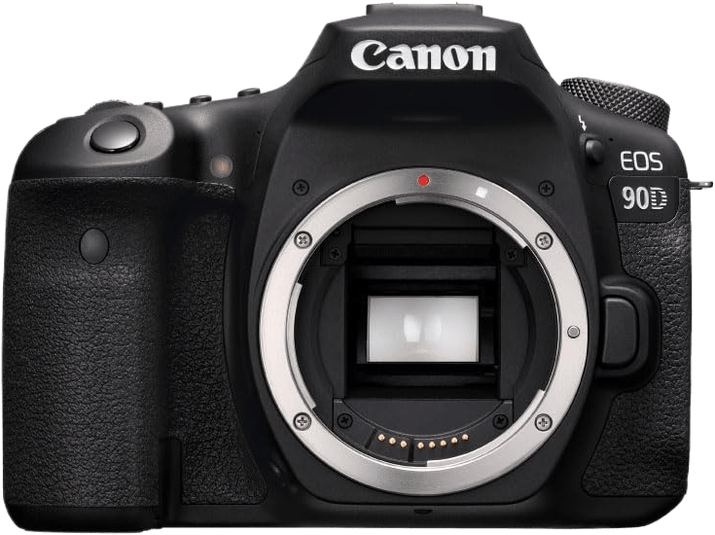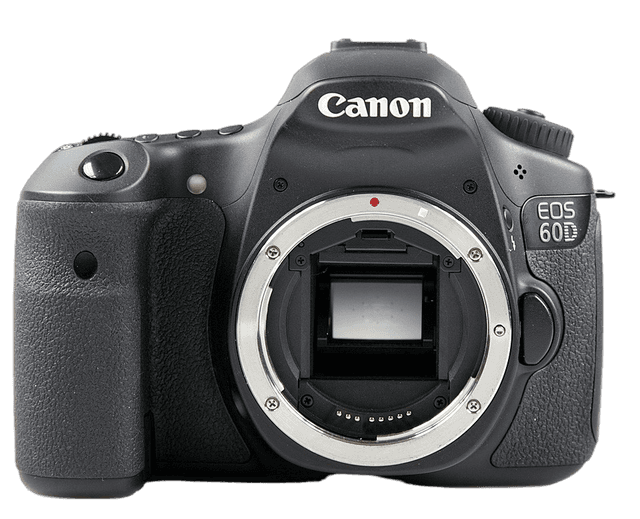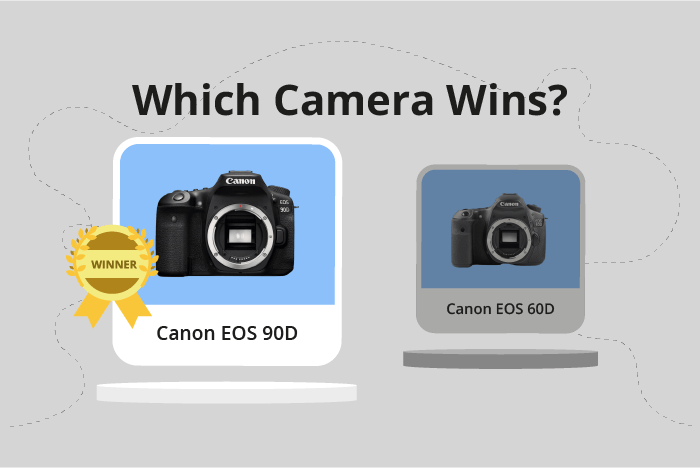Canon EOS 90D vs EOS 60D Comparison
Canon EOS 90D

Canon EOS 60D

The Canon EOS 90D outperforms the Canon EOS 60D with a score of 67/100 compared to 47/100. Both cameras are DSLRs and were launched at the same price of $1199. They share similar dimensions, with the 90D measuring 141 x 105 x 77mm and the 60D at 145 x 106 x 79mm. The 90D is lighter, weighing 701g, while the 60D weighs 755g.
The EOS 90D’s higher score showcases its advantages over the 60D, such as improved features and technology due to its 2019 release, nine years after the 60D. However, the 60D still offers value as a budget-friendly option for those seeking a reliable DSLR camera.
Considering the differences in scores, features, and release dates, the Canon EOS 90D is the superior choice for photographers seeking a more advanced DSLR camera. On the other hand, the Canon EOS 60D remains a viable option for those on a tighter budget.
Canon EOS 90D vs EOS 60D Overview and Optics
The Canon EOS 90D outperforms the Canon EOS 60D in optics with a score of 62/100, compared to the 60D’s 43/100. Both cameras possess several common specifications, such as the CMOS sensor type, APS-C sensor size, and the absence of image stabilization. Additionally, they both use the Canon EF lens mount system, with the 90D supporting EF-S lenses as well.
The 90D excels with its higher megapixel count at 33, compared to the 60D’s 18 megapixels. This difference allows the 90D to capture more detailed images. Furthermore, the 90D boasts a faster shooting speed of 10 frames per second, doubling the 60D’s 5.3. This improvement enables the 90D to capture fast-moving subjects with ease. The 90D also benefits from an upgraded processor, the Digic 8, which contributes to faster performance and improved image quality.
On the other hand, the 60D has a slightly better DXOMARK score for its sensor, at 66 compared to the 90D’s 58. This means that the 60D’s sensor performs better in terms of dynamic range, color depth, and low-light performance. However, this advantage is not enough to compensate for the 90D’s superior overall optics.
Taking all these factors into account, the Canon EOS 90D emerges as the clear winner in terms of optics, with its higher megapixel count, faster shooting speed, and advanced processor. The 60D, despite its marginally better sensor performance, falls short in comparison. Consequently, those seeking superior optics should opt for the Canon EOS 90D.
Canon EOS 90D vs EOS 60D Video Performance
The Canon EOS 90D outperforms the Canon EOS 60D in video capabilities with a significant score difference of 48 points, as the 90D scores 91/100 while the 60D scores 43/100. Both cameras have some similarities in their video specifications, but the 90D excels in various aspects.
Common features between the two cameras include their ability to record video in different resolutions and frame rates. The Canon EOS 90D and EOS 60D can both capture video, making them suitable for videography purposes.
The Canon EOS 90D is superior in its video performance due to its higher maximum video resolution of 4K (3840 x 2160), compared to the EOS 60D’s Full HD (1920 x 1080) resolution. This allows the 90D to produce more detailed and sharper videos. Additionally, the 90D can record at a higher maximum frame rate of 120fps, which is beneficial for capturing fast-moving subjects or creating slow-motion videos. Furthermore, the 90D has a built-in time-lapse functionality, enabling users to create stunning time-lapse videos without needing additional equipment or software.
On the other hand, the Canon EOS 60D is limited by its lower maximum video resolution and frame rate. However, its Full HD resolution is still suitable for casual videography and producing good-quality videos. The lower maximum frame rate of 30fps may be sufficient for most users, but it is not ideal for capturing fast action or slow-motion scenes.
Comparing the video capabilities of the Canon EOS 90D and EOS 60D, it is evident that the 90D is a better choice for those who prioritize video performance. With its higher maximum video resolution, faster frame rate, and built-in time-lapse functionality, the 90D provides more advanced and versatile video features for users. Meanwhile, the EOS 60D remains a suitable option for casual videographers who do not require the advanced features of the 90D.
Canon EOS 90D vs EOS 60D Features and Benefits
The Canon EOS 90D outperforms the Canon EOS 60D with a feature score of 83/100, while the 60D achieves a score of 57/100. Both cameras share some common specifications, including a 3-inch screen size and a screen resolution of 1,040,000 dots. Neither camera includes GPS functionality.
The EOS 90D surpasses the 60D in several aspects. Firstly, it comes with a touchscreen, providing users with a more intuitive and efficient way to navigate menus and settings. Additionally, the 90D offers built-in Wi-Fi and Bluetooth capabilities, promoting seamless connectivity and effortless sharing of images or remote control of the camera.
On the other hand, the EOS 60D has limited advantages over the 90D. Both cameras feature a flip screen, allowing for versatile shooting angles and improved photography experience. However, the 60D lacks the touchscreen, Wi-Fi, and Bluetooth functionalities found in the 90D.
In comparing these cameras, it becomes apparent that the Canon EOS 90D offers a superior user experience due to its touchscreen, Wi-Fi, and Bluetooth features. The EOS 60D, while still a competent camera, falls short in these areas. As a result, the Canon EOS 90D proves to be a better choice for photographers seeking enhanced functionality and connectivity in their camera.
Canon EOS 90D vs EOS 60D Storage and Battery
The Canon EOS 90D outperforms the Canon EOS 60D in storage and battery, scoring 48/100 compared to the 60D’s 45/100. Both cameras have one memory card slot and accept SD, SDHC, and SDXC cards. However, the 90D is UHS-II compatible, offering faster read and write speeds for improved performance.
The 90D also boasts a longer battery life, providing 1300 shots per charge with its LP-E6N battery, while the 60D manages 1100 shots with its LP-E6 battery. Neither camera offers USB charging.
Although the 60D falls short in these areas, it still provides a decent battery life and storage options suitable for most users.
Considering these factors, the Canon EOS 90D offers superior storage capabilities and battery life, making it the better choice for those who prioritize these features. The Canon EOS 60D remains a viable option for those who may not require the additional benefits provided by the 90D.
Alternatives to the Canon EOS 90D and EOS 60D
Are you still undecided about which camera is right for you? Have a look at these popular comparisons that feature the Canon EOS 90D or the Canon EOS 60D:

